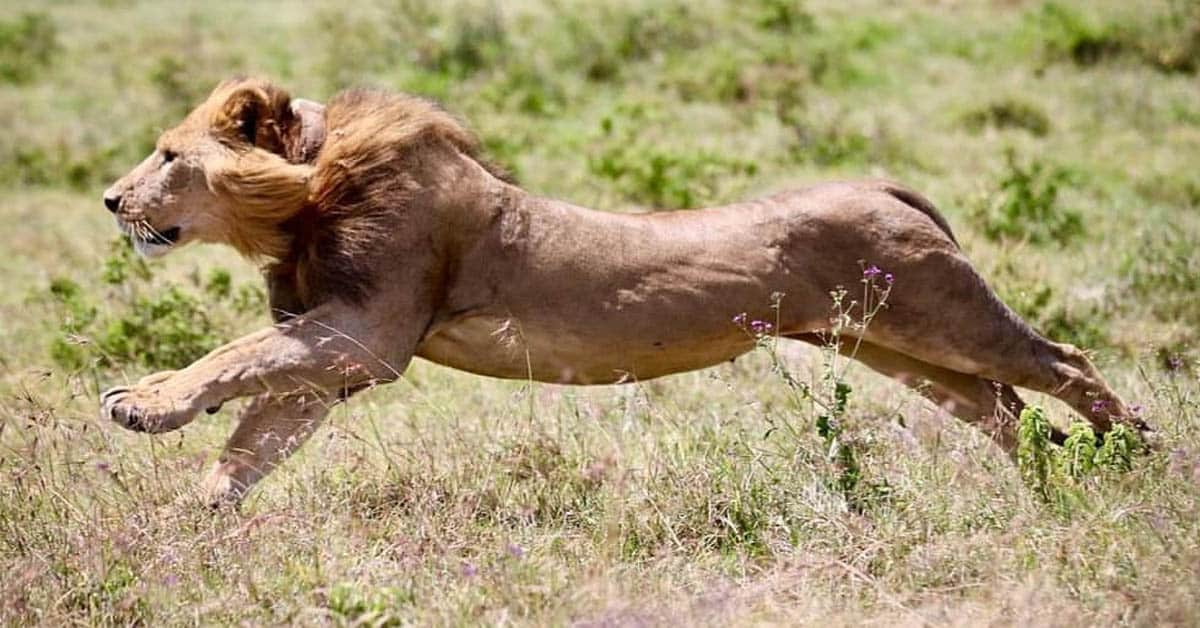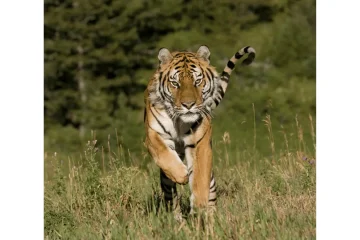As an Amazon Associate, I earn from qualifying purchases.
A lion can run at speeds of up to 50 miles per hour, making it one of the fastest land animals. Lions are known for their impressive speed and agility, capable of reaching speeds of up to 50 miles per hour in short bursts. This article from the teamkathycarter website discusses about How Fast Can a Lion Run?
This remarkable ability is essential for hunting and catching prey, as well as for evading potential threats in the wild. The combination of their powerful muscles and strong physique enables them to accelerate quickly and cover ground rapidly. Understanding the impressive speed of lions provides insight into their hunting prowess and overall survival in their natural habitat.
The King Of Speed: Lion’s Top Running Facts
The lion, also known as the king of the jungle, is not only majestic and powerful but also incredibly fast. In this section, we will explore the top running facts about lions, including their sprinting and endurance capabilities.
Sprint Vs. Endurance: A Lion’s Racing Strategy
Lions are known for their exceptional sprinting abilities, which they rely on when hunting prey. With their muscular build and strong legs, lions can reach impressive speeds in short bursts. However, their speed is not sustainable for long distances. Instead, lions rely on their endurance to outlast their prey during a chase.
During a sprint, a lion can reach speeds of up to 50 miles per hour. This incredible velocity allows them to quickly close the gap between themselves and their intended target. With each powerful stride, the lion’s muscles propel it forward, making it a formidable force in the animal kingdom.
However, when it comes to endurance, lions can maintain a steady pace for several miles. While not as fast as their sprinting speed, a lion can cover distances of up to 20 miles in a single day. This ability comes in handy during long hunts or when lions need to patrol their territories.
Breaking Down The Numbers: How Fast, How Far
Let’s break down the numbers to get a better understanding of a lion’s running capabilities:
|
Speed |
Distance |
|---|---|
|
50 miles per hour |
Short bursts |
|
20 miles |
Endurance |
-
Lions can sprint at speeds of up to 50 miles per hour.
-
They can cover distances of up to 20 miles in a day.
These numbers highlight the impressive running abilities of lions. Whether it’s a quick chase or a long-distance pursuit, lions are well-equipped to navigate their surroundings with speed and endurance.
Lion Physiology: Built For The Chase
Muscle Power: The Engine Behind The Speed
Lions are renowned for their incredible speed, a key attribute that allows them to hunt and survive in the wild. The secret behind their impressive speed lies in their powerful muscles, specially adapted for explosive bursts of energy.
Adaptations For Acceleration: An Anatomical Overview
Lions’ bodies are finely tuned for acceleration, with various anatomical adaptations that enhance their ability to sprint after prey. From their muscular hindquarters to their flexible spines, every aspect of their physiology is optimized for swift and agile movement.
Comparing The Big Cats: Where Lions Stand
When it comes to speed in the animal kingdom, big cats have always fascinated us with their incredible agility and swiftness. Among these majestic creatures, the lion holds a special place as the king of the jungle. In this section, we will explore how lions compare to other big cats in terms of their running abilities.
Cheetah Vs. Lion: A Study In Speed
When it comes to speed, the cheetah is undeniably the reigning champion of the animal kingdom. Known for its remarkable acceleration and ability to reach incredible speeds, the cheetah can sprint at an astonishing rate of up to 70 miles per hour (112 kilometers per hour). This makes the cheetah the fastest land animal on the planet.
On the other hand, the lion is not built for sheer speed like the cheetah. While lions are undoubtedly powerful predators, their speed is more focused on short bursts rather than sustained sprints. A lion can reach speeds of up to 50 miles per hour (80 kilometers per hour) when chasing prey over a short distance.
Lion, Tiger, Leopard: Ranking The Runners
Now, let’s delve into a comparison of the running abilities of lions, tigers, and leopards, three of the most iconic big cats in the world.
|
Big Cat |
Maximum Speed (mph) |
|---|---|
|
Lion |
50 |
|
Tiger |
40 |
|
Leopard |
36 |
From the table, it is evident that the lion holds the crown for the fastest running speed among these three big cats. Tigers and leopards, although formidable runners in their own right, fall slightly behind the lion in terms of top speed.
It is important to note that the running speed of these big cats can vary depending on factors such as age, health, and the specific circumstances of a chase. These numbers represent the maximum speeds recorded for each species.
In conclusion, while the lion may not be the fastest big cat in the animal kingdom, its impressive speed and agility make it a formidable predator in its natural habitat. Whether it’s chasing down prey or defending its territory, the lion’s running abilities are a testament to its status as the king of the jungle.
Credit: www.learnaboutnature.com
Hunting Techniques: Speed In Action
When it comes to hunting, speed is a crucial factor for lions. These majestic creatures have evolved to be exceptional predators, relying on their agility and quickness to capture their prey. In this section, we will delve into the hunting techniques of lions and explore how their remarkable speed plays a pivotal role in their success.
The Art Of Ambush: How Lions Capture Prey
Lions are masters of the ambush. They utilize their remarkable speed to quickly close the distance between themselves and their unsuspecting prey. With stealthy movements and an acute sense of timing, lions patiently stalk their target before launching a lightning-fast attack. This allows them to take their prey by surprise, increasing their chances of a successful kill.
When the moment is right, lions burst into action, sprinting towards their prey with incredible speed. With every powerful stride, their muscular bodies propel them forward, enabling them to reach impressive speeds in a matter of seconds. In a full-out sprint, lions can reach speeds of up to 50 miles per hour (80 kilometers per hour), making them one of the fastest land animals on the planet.
Teamwork In The Pride: Coordinating The Hunt
While speed is essential for individual lionesses and male lions during hunts, it is the coordination and teamwork within the pride that truly sets them apart. Lions often hunt in groups, working together to maximize their chances of a successful kill. This cooperative behavior allows them to take down larger and more formidable prey.
During a hunt, lions communicate through vocalizations and body language, coordinating their movements to surround their chosen target. Each member of the pride plays a specific role, from driving the prey towards waiting ambushers to providing backup in case the initial pursuit fails. By working together, lions create a formidable force that increases their chances of a successful kill.
The speed of individual lions is not only crucial for capturing prey but also for maintaining cohesion and coordination within the pride during a hunt. Lions’ ability to swiftly react to changing circumstances and adjust their strategies accordingly ensures a higher likelihood of a successful hunt.
In conclusion, the hunting techniques of lions revolve around their incredible speed, which allows them to execute ambushes with precision and efficiency. Furthermore, their coordination and teamwork within the pride enhance their chances of securing a meal. The combination of speed, stealth, and cooperation makes lions formidable hunters in the animal kingdom.
Factors Affecting Lion Speed
Lion speed is influenced by factors like age, health, and distance to cover. Adult lions can reach speeds of up to 50 mph in short bursts, making them formidable predators in the wild. The terrain and prey also play a role in determining how fast a lion can run.
When it comes to discussing lion speed, it’s important to consider the various factors that can influence this majestic creature’s pace. Age and health, as well as the environment, play a crucial role in a lion’s ability to run and hunt its prey. Let’s explore these two factors further and see how they impact a lion’s speed.
Age And Health: Vital Speed Variables
Just like humans, lions experience a decline in their physical abilities as they age. Young lions, for example, are known to be faster and more agile than older lions. Additionally, a lion’s health can also affect its speed. Lions that suffer from injuries or illnesses may not be able to run as fast as their healthy counterparts. It’s worth noting that male lions are generally larger and heavier than females, which can also affect their speed.
The Role Of The Environment In Lion Pursuits
The environment in which a lion is hunting can also have a significant impact on its speed. Lions are known to be faster on open terrain, such as savannas, where they can run at speeds of up to 50 mph (80 km/h). However, in dense forests or areas with thick vegetation, lions may not be able to run as fast due to obstacles and limited visibility. Additionally, the weather can also play a role in a lion’s speed. In hot and humid conditions, lions may tire more quickly and not be able to run as fast or as far. Overall, while a lion’s speed can vary based on age, health, and environment, it’s still an impressive and powerful predator that is capable of running at incredible speeds when necessary.
Credit: africafreak.com
Speed Limitations: When Lions Aren’t The Fastest
Prey Escape Tactics: Outrunning The Hunter
Lions rely on speed to catch their prey, but there are instances where they are not the fastest in the savannah.
The Cost Of Speed: Energy And Survival
Despite their agility, lions have limitations when it comes to chasing down certain prey.
Conservation Efforts: Preserving The Fast And The Fierce
Conservation Efforts: Preserving the Fast and the Fierce
Threats To Lion Habitats: Impact On Speed
Lion habitats are shrinking due to human encroachment and poaching.
-
Deforestation
-
Illegal hunting
Global Initiatives: Keeping The Lion’s Pace
Organizations worldwide work to protect lion habitats and prevent extinction.
-
Protected reserves
-
Community education programs
Lions In Culture: Symbolism Of Speed And Strength
Lions have long been revered for their speed and strength in various cultures around the world.
Literature And Mythology: The Lion’s Sprint
In ancient tales, lions are often depicted as swift creatures, symbolizing power and agility.
Modern Media: Portraying The Speed Of Lions
In today’s movies and documentaries, lions are showcased for their incredible running ability.
Credit: www.quora.com
Frequently Asked Questions
Can A Human Outrun A Lion?
No, a human cannot outrun a lion. Lions can run up to 50 mph, while the fastest human can only run up to 28 mph. It’s not possible to outrun a lion, but you can try to avoid being seen or make loud noises to scare them away.
Is A Lion Faster Than A Tiger?
The lion is faster than the tiger, with speeds reaching up to 50 miles per hour.
What Is A Lion’s Top Speed?
A lion’s top speed can reach up to 50 miles per hour. They are incredibly fast runners, allowing them to chase down and capture their prey with agility and speed. Lions are known for their impressive bursts of speed when hunting.
What Is The Fastest Animal On Earth?
The fastest animal on Earth is the peregrine falcon, reaching speeds of up to 240 mph when diving.
Conclusion
A lion can run at speeds of up to 50 miles per hour, making it one of the fastest land animals. This incredible speed allows lions to hunt effectively and cover large distances in search of prey. Understanding the impressive running abilities of lions adds to our appreciation of these majestic creatures.
As an Amazon Associate, I earn from qualifying purchases.




